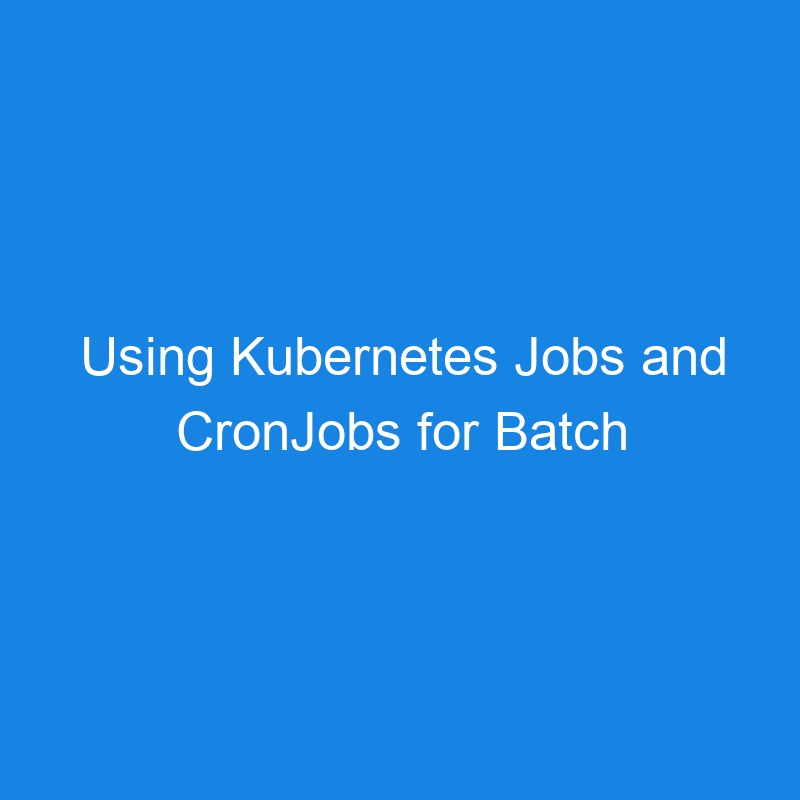Using Kubernetes Jobs and CronJobs for Batch Processing
Kubernetes Jobs and CronJobs are powerful constructs for managing batch and scheduled workloads in Kubernetes. These constructs allow for robust, automated task execution within a cluster, making them ideal for scenarios like data processing, backups, and periodic tasks. This article delves into the details of these resources, including their functionality, use cases, and best practices.
Kubernetes Jobs
A Kubernetes Job is a resource used to manage the execution of one or more pods until a task is completed successfully. Jobs are suitable for tasks that are finite and do not run continuously.
Features of Jobs:
- Guaranteed Completion: A Job ensures that a specified number of pods successfully complete their tasks.
- Retries: If a pod fails, the Job controller will automatically retry it.
- Parallelism: Jobs can be configured to run multiple pods in parallel to complete a task faster.
Use Cases:
- Data Processing: Extract, Transform, Load (ETL) pipelines.
- One-Time Tasks: Database migrations, data cleanup scripts.
- Batch Workloads: Image processing, report generation.
- System Tasks: Running diagnostics or fixing inconsistencies.
Job Configuration Example:
Here is a simple YAML configuration for a Kubernetes Job:
apiVersion: batch/v1
kind: Job
metadata:
name: example-job
spec:
completions: 1
parallelism: 1
template:
spec:
containers:
- name: example-container
image: busybox
command: ["/bin/sh", "-c", "echo Hello Kubernetes! && sleep 10"]
restartPolicy: Never
Key Components:
-
completions: The total number of pods that must successfully run to complete the Job. Defaults to 1. -
parallelism: Specifies how many pods can run concurrently. Defaults to 1. -
restartPolicy: Must be set toNeverorOnFailurefor Jobs.
In this example, the Job runs a container that prints a message and sleeps for 10 seconds. The task is completed once the pod successfully runs.
Kubernetes CronJobs
A Kubernetes CronJob builds upon Jobs to enable scheduled execution. It is similar to traditional cron in Linux systems, allowing tasks to run at specified intervals.
Features of CronJobs:
- Scheduled Execution: Tasks can be scheduled using cron expressions.
- Periodic Tasks: Ideal for recurring tasks like backups or report generation.
- Controlled Retention: You can specify how many successful and failed Job records to retain.
Use Cases:
- Database Backups: Automating periodic snapshots.
- Log Rotation: Cleaning up or archiving old logs.
- Health Checks: Running system health diagnostics at intervals.
- Report Generation: Creating daily, weekly, or monthly reports.
CronJob Configuration Example:
Here is a YAML configuration for a CronJob:
apiVersion: batch/v1
kind: CronJob
metadata:
name: example-cronjob
spec:
schedule: "*/5 * * * *"
jobTemplate:
spec:
template:
spec:
containers:
- name: example-container
image: busybox
command: ["/bin/sh", "-c", "echo Running scheduled task"]
restartPolicy: OnFailure
successfulJobsHistoryLimit: 3
failedJobsHistoryLimit: 1
Key Components:
-
schedule: A cron expression specifying the execution schedule. For example,"*/5 * * * *"runs the task every 5 minutes. -
jobTemplate: Defines the Job specification that the CronJob will create. -
successfulJobsHistoryLimit: Limits the number of successful Job records to retain. -
failedJobsHistoryLimit: Limits the number of failed Job records to retain.
Best Practices for Jobs and CronJobs
- Resource Limits: Always define resource requests and limits to avoid overloading your cluster.
- Monitoring and Logging: Use tools like Prometheus, Grafana, or Kubernetes native logs to monitor Job executions and diagnose failures.
-
Concurrency Control: For CronJobs, configure
concurrencyPolicyto control overlapping executions. Options include:-
Allow(default): Allows concurrent executions. -
Forbid: Prevents new executions if the previous Job is still running. -
Replace: Stops the currently running Job and starts a new one.
-
-
Retention Policies: Set
successfulJobsHistoryLimitandfailedJobsHistoryLimitto manage record storage and avoid clutter. -
Backoff Limit: Define
backoffLimitto limit the number of retries for failed Jobs. - Namespace Separation: Use namespaces to logically group and isolate Jobs or CronJobs, especially in multi-tenant environments.
- Testing: Test your Job and CronJob configurations in a staging environment before deploying to production.
Advanced Topics
Parallelism in Jobs:
For large-scale data processing, you can use parallelism and completions together to divide tasks among multiple pods:
spec:
parallelism: 4
completions: 8
This configuration runs 4 pods concurrently and completes the Job after 8 pods have successfully run.
CronJob Timezone Support:
CronJobs use the cluster’s timezone by default. To run tasks in a specific timezone, adjust your Job’s scheduling logic within the container.
Scaling CronJobs:
If multiple CronJobs cause resource contention, consider scaling your cluster or staggering schedules to balance the load.
Common Issues and Troubleshooting
-
Pods Stuck in Pending State:
- Check for resource constraints (CPU, memory).
- Ensure the node has sufficient capacity.
-
Jobs Not Retrying:
- Verify
backoffLimitandrestartPolicysettings.
- Verify
-
CronJobs Missing Schedules:
- Confirm the
schedulesyntax is correct. - Check the cluster’s timezone and adjust if necessary.
- Confirm the
-
Logs Not Accessible:
- Ensure proper logging configurations and storage.
Conclusion
Kubernetes Jobs and CronJobs provide a robust way to handle batch processing and scheduled tasks in containerized environments. By leveraging their features, you can automate a wide range of workflows, from one-off tasks to recurring processes. With proper configuration, monitoring, and scaling, these tools can significantly enhance the efficiency and reliability of your workloads.
